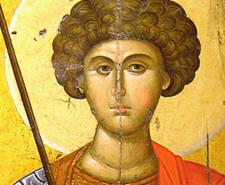
Read more about Ancient History

St. George’s Day is recognised on 23rd April in England and is the commemoration and celebration of the country’s patron saint. It is no longer a national holiday or a huge national event, but it still is a significant piece of English history and is celebrated by lots of people.
St George’s Day 2024 will take place on a Tuesday and be a chance to celebrate the history behind St. George and what he represents in England.
Even the question of who St. George was is sometimes questioned, with people arguing he is nothing more than a figure of legend. However, most agree that he was a soldier in the earliest recorded times. He was born around the year 280 AD in what is now Turkey. He became a soldier and rose through the ranks of the Roman army, eventually working as a personal guard to the emperor. St. George was executed for his Christianity on 23rd April 303 AD and is said to be buried in the town of Lod in modern-day Israel.
St George is widely known for slaying a dragon. According to the legend, the well in the town of Silene in Libya was guarded by a dragon. In order to access water, the townspeople were made to offer a human sacrifice every day to the dragon.
The person to be sacrificed was chosen by lots. When St. George was visiting, a princess had been selected to be sacrificed. However, he killed the dragon, saved the princess, and gave the people of Silene water. In thanks for his actions, the people converted to Christianity, furthering St. George’s mission.
St. George’s Day used to be a significant event in the English calendar and was celebrated as widely as Christmas. However, the celebrations became less common at the end of the 18th century when England and Scotland reunited. While the day is often discussed in schools, it is not really something people celebrate on a grand scale across the country.
Traditionally, people may have held a feast and arranged some dancing and local festivities including traditional crafts, Punch & Judy shows and Morris dancing.
The most widely recognised symbol of St George's Day is St George's Cross. This is a red cross on a white background, most recognisable as England’s national flag. St. George's Cross was originally the flag of the maritime Republic of Genoa, but from around 1190, the King of England started paying the Doge of Genoa to protect ships from the city of London and the rest of England that sailed in the Mediterranean. St. George’s Cross became an intrinsic part of English culture from this day forward.
St. George’s Cross is also closely linked to the historic Christian crusades of the 10th and 11th centuries. English knights used St George's Cross as part of their uniform, and it became synonymous with Christian crusaders from England across Europe
St. George never set foot on English soil. His reputation for virtue and holiness preceded him and made him a famous figure across Europe. He was adopted by the English from around the 9th century.
He was particularly popular with Edward I and Edward III who were interested in his story and wanted to display the St. George’s Cross as a symbol of England.
The Order of the Garter was founded by Edward III in 1348 and is the highest order of chivalry in England. The St. George’s Cross appears on the Garter badge and his image is etched onto the pendant of the Garter chain. In 1940, the George Cross was also created by George VI as the highest award for non-operational gallantry.
While it was named after the King, the George Cross features the traditional image of St. George vanquishing the dragon. You will also see the image of St. George on many military graves and memorials to this day.
The campaign for St. George’s Day to be a national holiday argues that thousands of people in England believe the patron saint’s day should be a bank holiday. They argue we should be promoting England’s national day and the volunteers behind the campaign regularly lobby MPs and local councils.
The story of St. George was well-told and well-loved across Europe, meaning he is held up as a national figure and saint for many nations. Other nations including Bulgaria, Georgia, Greece, Portugal and Russia all consider St. George their patron saint, and he’s even held in high regard as far afield as Canada and Ethiopia.